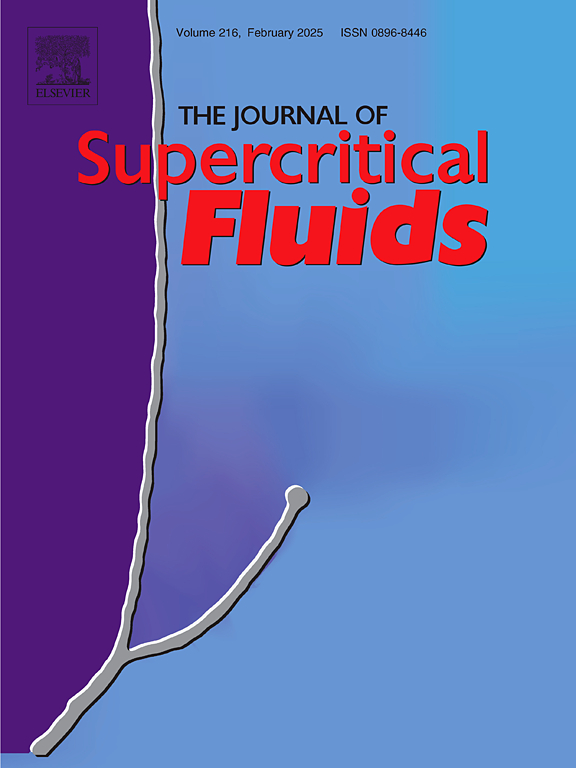超临界CO2中药物溶解度的理论认识:热力学建模和机器学习研究
IF 4.4
3区 工程技术
Q2 CHEMISTRY, PHYSICAL
引用次数: 0
摘要
药物在超临界CO2中的溶解度的实验和理论研究对于优化药物配方中的超临界技术至关重要。本研究利用各种理论模型,包括经验模型、非三次状态方程(PC-SAFT)、Sodeifian最近提出的扩展液体模型、规则溶液模型和人工神经网络方法(ANN),探讨氯噻嗪和氯喹这两种低溶解度和生物利用度的药物在超临界CO₂中的溶解度。通过将这些模型的结果与先前记录的实验数据进行比较,验证了这些模型在预测和分析所需药物在超临界CO2中的溶解度方面的可靠性,实验温度为308 K至338 K,氯噻嗪的压力为130 bar至290 bar,氯喹的压力为120 bar至400 bar。研究发现,所有经验模型和热力学模型在两种药物的溶解度相关性方面都提供了令人满意的准确性,AARD值低于10 %。对于氯噻嗪,最准确的模型为经验模型(AARD%= 1.78 ~ 2.72),其次为PC-SAFT模型(AARD%= 5.23)、Sodeifian模型(AARD%= 8.257)和常规溶液模型(AARD%= 9.77 ~ 10.9)。对于氯喹,其排序略有不同,PC-SAFT模型(AARD% = 4.15)效果最好,其次是经验模型(AARD% = 7.1 ~ 8.3)、Sodeifian模型(AARD% = 7.94)和常规溶液模型(AARD% = 8.03 ~ 9.74)。此外,基于人工神经网络的多层感知器(MLP),使用贝叶斯正则化和Levenberg-Marquardt反向传播进行训练,取得了卓越的准确性,超过99% %的预测与超临界CO2中的实验溶解度数据非常匹配。本文章由计算机程序翻译,如有差异,请以英文原文为准。
Theoretical understanding of pharmaceutics solubility in supercritical CO2: Thermodynamic modeling and machine learning study
Both experimental and theoretical studies of drug solubility in supercritical CO2 are essential for optimizing supercritical techniques in pharmaceutical formulation. This study explores the solubility of Chlorothiazide and Chloroquine, two drugs with low solubility and bioavailability, in supercritical CO₂ using various theoretical models, including empirical models, a non-cubic equation of state (PC-SAFT), a recently developed expanded liquid model proposed by Sodeifian, the regular solution model, and artificial neural network method (ANN). The reliability of these models in predicting and analyzing the solubility of the desired drugs in supercritical CO2 is validated by comparing their results with experimental data previously recorded at temperatures between 308 K to 338 K and pressures ranging from 130 bar to 290 bar for Chlorothiazide and 120 bar to 400 bar for Chloroquine. The study found that all empirical and thermodynamic models provided satisfactory accuracy in correlating the solubility of both drugs, with AARD values below 10 %. For Chlorothiazide, the most accurate models were the empirical models (AARD%= 1.78–2.72), followed by PC-SAFT (AARD% = 5.23), the Sodeifian model (AARD% = 8.257), and the regular solution model (AARD% = 9.77–10.9). For Chloroquine, the ranking was slightly different, with PC-SAFT (AARD% = 4.15) performing the best, followed by the empirical models (AARD% = 7.1–8.3), the Sodeifian model (AARD% = 7.94), and the regular solution model (AARD% = 8.03–9.74). Moreover, the ANN-based multilayer perceptron (MLP), trained using Bayesian Regularization and Levenberg-Marquardt backpropagation, achieved exceptional accuracy, with over 99 % of predictions closely matching the experimental solubility data in supercritical CO2.
求助全文
通过发布文献求助,成功后即可免费获取论文全文。
去求助
来源期刊

Journal of Supercritical Fluids
工程技术-工程:化工
CiteScore
7.60
自引率
10.30%
发文量
236
审稿时长
56 days
期刊介绍:
The Journal of Supercritical Fluids is an international journal devoted to the fundamental and applied aspects of supercritical fluids and processes. Its aim is to provide a focused platform for academic and industrial researchers to report their findings and to have ready access to the advances in this rapidly growing field. Its coverage is multidisciplinary and includes both basic and applied topics.
Thermodynamics and phase equilibria, reaction kinetics and rate processes, thermal and transport properties, and all topics related to processing such as separations (extraction, fractionation, purification, chromatography) nucleation and impregnation are within the scope. Accounts of specific engineering applications such as those encountered in food, fuel, natural products, minerals, pharmaceuticals and polymer industries are included. Topics related to high pressure equipment design, analytical techniques, sensors, and process control methodologies are also within the scope of the journal.
 求助内容:
求助内容: 应助结果提醒方式:
应助结果提醒方式:


